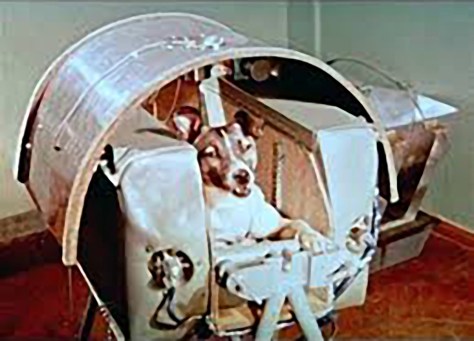War Dogs History after WW2 to the Fall of Berlin Wall. After a military history that seemed to have snowballed between the Great War and the Second World War, what happened to these specially trained canine soldiers once dust settled over the Paris Peace Treaties?
Dogs have been man’s best friend from prehistorical times and they might have even helped the human brain evolve. Dogs joined kings in battles, proving indispensable so, one day, rigorous dog training began. Our beloved canines were amazing during WW1 in trenches, as ambulance and messenger dogs, and even as sled dogs. Lest we forget the amazing stories they were involved in during WW1, as cute mascots, military dogs made it into WW2 helping out the British, the Americans, with the first K-9 unit, and, with their unprejudiced hearts, the Germans and the Japanese. Did someone said paradogs? They are the flying dogs, indispensable during WW2.

Military Dogs during the Korean War
As there were still U.S. Army troops that remained in Korea after the end of WW2, due to the Cold War, they stayed put in the south after the Communist government was established in North Korea. Therefore more than one hundred U.S. military dogs were already stationed in Seoul at the outbreak of the Korean War on 25 June 1950.

The sentry dogs were quickly trained for combat situations. The the 26th Infantry Scout Dog Platoon was the U.S. dog sent unit to fight in Korea. Back home, the dogs were trained at the Army Dog Training Center at Fort Carson
“The 26th Infantry Scout Dog Platoon is cited for exceptionally meritorious conduct in the performance of outstanding services in direct support of combat operations in Korea during the period 12 June 1951 to 15 January 1953.
Korean War, General Orders Citation

Thoughts on deactivating the Army Dog Training Center at Fort Carson, in 1957:
“While fighting in Korea I was attacked and one of these dogs took over my attacker and I was able to recover my footing and escaped. Please reconsider.”
Frank Conanno, 1470 Third Street, West Babylon, N. Y.
“I am in the Army and was put into the scout dog platoon and trained dogs for nine months in the States and have had the same dog all the times. This dog STAR has saved my life and about twelve other men’s lives. I would like to know if there is any way that I could have him discharged the same time that I am. I would gladly pay the Government for the dog and take all the responsibility for him.
Cpl, Max Meyers, 26th Infantry, Scout Dog Platoon, APO #60 San Francisco, Calif.
“I would appreciate it very much if you could help me in any way so I could take him home with me. This dog is not dangerous and would be suitable to civilian life.”
At the end of he Korean War, some scout dogs were put on sentry duty at various Dog Platoons in the U.S.
Laika, first dog in space, 1957

Laika was he first dog in space, November 1957, on board of Sputnik 2, the second spacecraft launched into Earth orbit by the Soviet Union. Sadly, Laika survived for several orbits but died a few hours after the launch.
Laika was part husky or other Nordic breed, part terrier, once again proving that a brave heart is worth more than a pedigree.
The American press dubbed Laika Muttnik: mutt + suffix -nik
Military dogs during the Vietnam War
Below: two sniffer dogs that served in the Vietnam War, 1967, South Vietnam, with the 7th Battalion Royal Australian Regiment. Justin is left, and Cassius is right, pictured here with Lance Corporal Thomas Douglas and Cpl. Norman Leslie. Cpl Blackhurst, a radio operator, was killed in action in April 1971 while calling in a helicopter for a medical evacuation. The helicopter crashed, killing L Cpl. Blackhurst, another officer on the ground, as well as the medic on board.

In Vietnam there was a specialized requirement for tunnel dogs to detect and explore the tunnels exploited by the Vietnam Cong (National Liberation Front). The tunnel dwellers feared the U.S. dogs and used tactics to confuse them. For example they washed with GI soap and covered air vents with shirts taken from Americans so the dogs’ sense of smell would not be alerted.

Sadly, the war dogs deployed to Vietnam during that conflict, 1955 – 1975, were classified as “surplus equipment” and left behind, no matter what their human handler and buddies believed. When U.S. troops withdrew in 1973, most of the 4,000 U.S. military dogs on the ground there were deemed “surplus equipment,” and left behind. Some were given to South Vietnamese forces, while others were euthanized.

The Prison Riot of 1996 and the first dog body armor
The Winnipeg prison riot of 1996 might not have made the international news, but the two days of horror have been enough for Jim Slater, a former dog handler for the Winnipeg police department, who adjusted a human flak jacket on his canine partner Olaf.
“He was out working ahead of our lines,” he says. “I realized it would be a bad way for him to go down, stabbed with a screwdriver.”
Jim Slater for Money.com
Orders for more bullet proof jackets for dogs soon began to pour from fellow canine officers.

Military Working Dogs in the Israeli Special Forces
Founded in 1939 as Hagana ( when canines were used for the security of Jewish villages threatened by their Arab neighbors), the Oketz Unit (Oketz is Hebrew for “sting”) is the independent canine special forces (sayeret) unit of the Israel Defense Forces. Initially, Oketz trained dogs to attack kidnappers, but today their dogs undergo specialized training: attack, tracking, sniffer dogs (especially ammunition and hidden explosives) and finding people in collapsed buildings.

The Oketz military base has a pet cemetery, the final resting place of over 60 four-legged recruits. A testimony to the increasingly significant role that dogs have come to play in the ranks of the military and of the never ending bond that forms between them and their human handlers.

Fighting terrorists or taking part in the Gaza-Israel conflict, when a Israeli military dog happens to be torn apart by a land mine he is officially registered as missing in combat. “Our troops train as one – man and dog... It’s less about you and more about you and the dog together, what you can do together.”

“Since 2002, soldiers and dogs from Oketz have been able to prevent at least 200 suicide attacks in the central region”
Israeli officer says.

Unlike other combat troops in the IDF, Oketz soldiers carry three liters of water on them during operations – 1.5 liters for themselves and 1.5 liters for the dogs. (Source: The Jerusalem Post)
In 2017, India announced that it had bought 30 Oketz attack dogs, bomb sniffers and chasers from Israel because “the new four-legged recruits to the Special Protection Group are considered the best in the world in sniffing out explosive booby-traps.”
The Jerusalem Post

Bosnian War
“On numerous occasions and on numerous deployments I have seen battle-hardened men pouring affection on stray dogs that happen to frequent their bases, and often try to adopt them. I remember in Bosnia, in the deep snow of Mrkonič Grad where we were holed-up in an old, windy bus depot, there was a huge mongrel, clearly the alpha male, that used to lay in the snow permanently surveying his empire, confident that as each unit passed through on its 6-month rotation, someone would make sure that he was well looked after.”
Lieutenant Colonel David Eastman, British Army Blog
1989, the Berlin Wall comes down
Before 9 November 1989, when the Berlin Wall came down, the East German Communist Government used over 6000 dogs for patrol along the wall, known as “Wall Dogs”. A special breed was raised for this reason alone, DDR (Deutsche Demokratische Republik) Shepherd: dogs that excelled in tracking, were athletic, tough, had excellent climbing abilities, and could withstand extreme physical conditions and demands.

These dogs were tied to a 5m long chain attached to a steel cable that ran approximately 100m in length along the Berlin Wall. Their life was tough, were treated with extreme cruelty. Barely fed every two days, they went through a (short) life with barely any human contact. They soon developed the “wall syndrome”: barking incessantly even when they could hardly stand. Some were killed when they could no longer perform their guard duty, some strangled themselves when their own leads got tangled.

After the Wall came down and these guard dogs were no longer needed, they were mostly abandoned. The German Association for the Protection of Animals did everything they could to save as many Wall dogs as possible. Some say that the adopted Wall dogs, when approaching the area where the wall once stood, would
“move as if tethered to an unseen leash, with absolute certainty, following the old border along its zigzags through the city”.
Is one happy ending enough?
Between the Wall Dogs, whose difficult reputation made it difficult for them to be adopted, two German Shepherds, Juro and Betty, and a Schnauzer called Valco, were adopted in March 1990 by a family in Mallorca, Spain.

The history of Military Working Dogs, or War Dogs, is long and sad. Have humankind learned anything from these amazing souls, who give unconditionally, forget and always offer second chances?
Next post: MWDs encountered in the Gulf War, Iraq War and the War in Afghanistan. Do return for some amazing images and more canine history.


A truly lovely post and one I enjoyed reading immensely.
Thank you so much, Daniel. I must confess, I had quite a few flashbacks writing this one.
Hi Patricia. Thank you for visiting and following HoB. Much appreciated!
My pleasure, Herman. I enjoyed your blog and will revisit soon.
Thank you very much for stopping by. Hope to see you again.